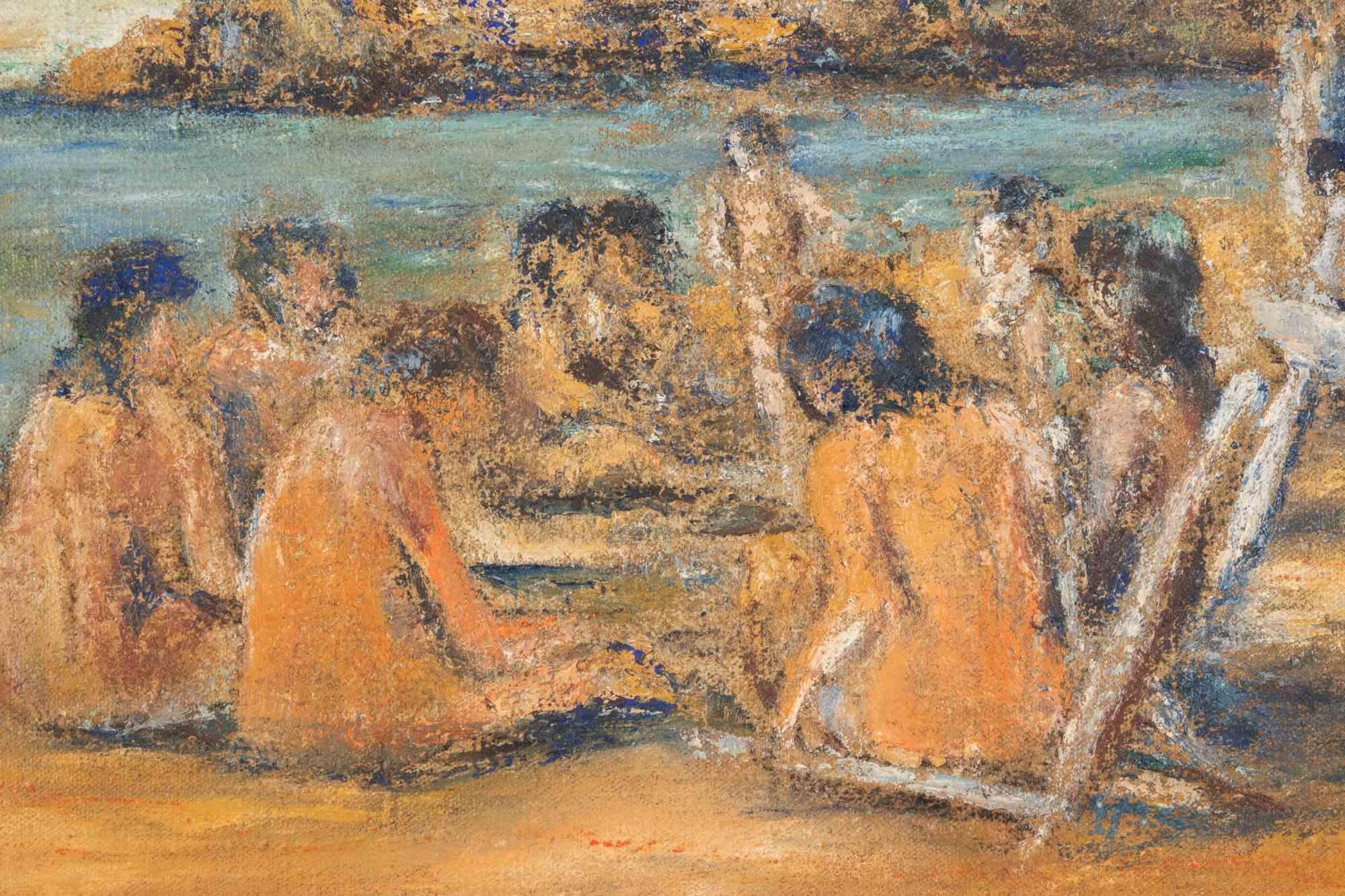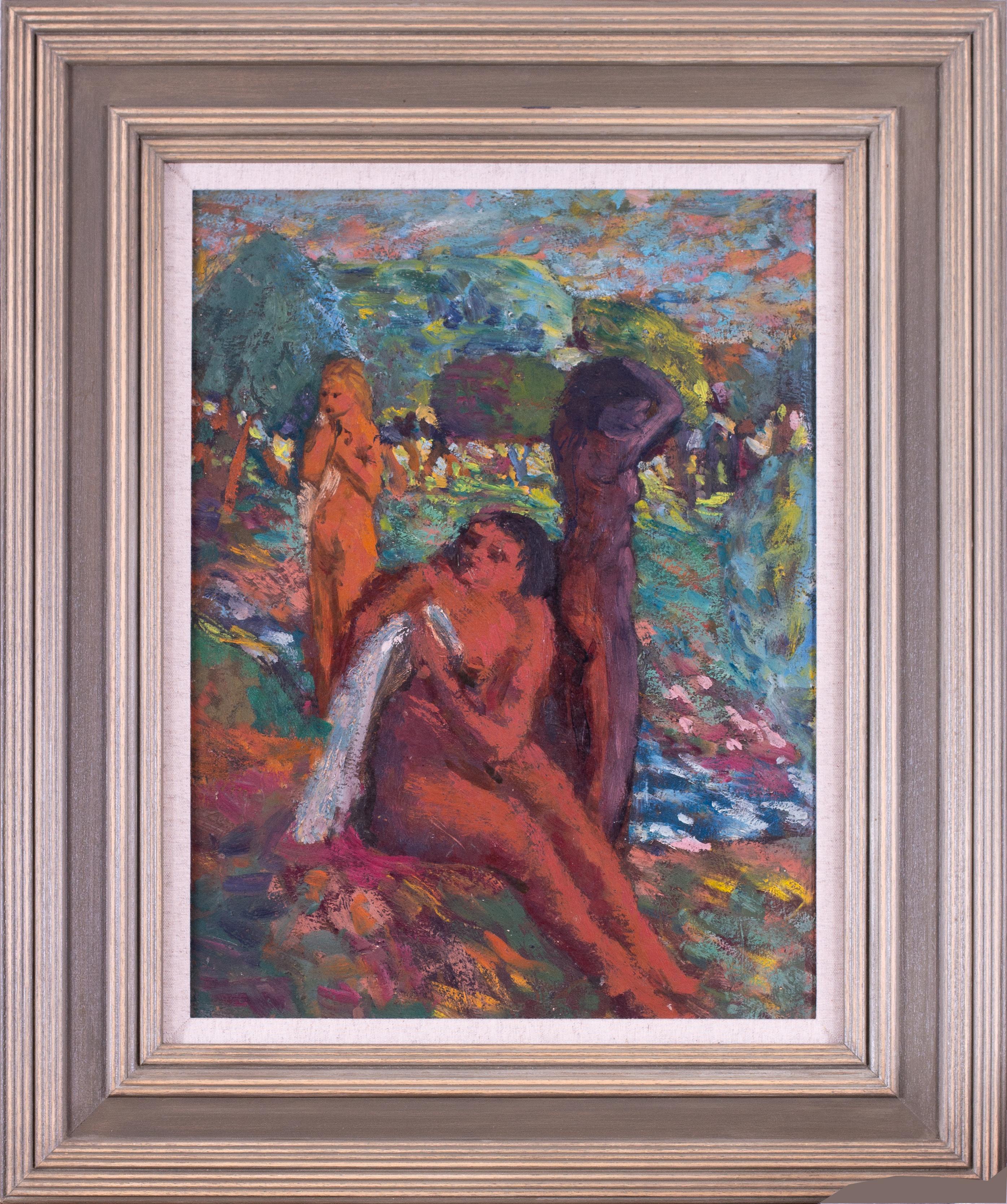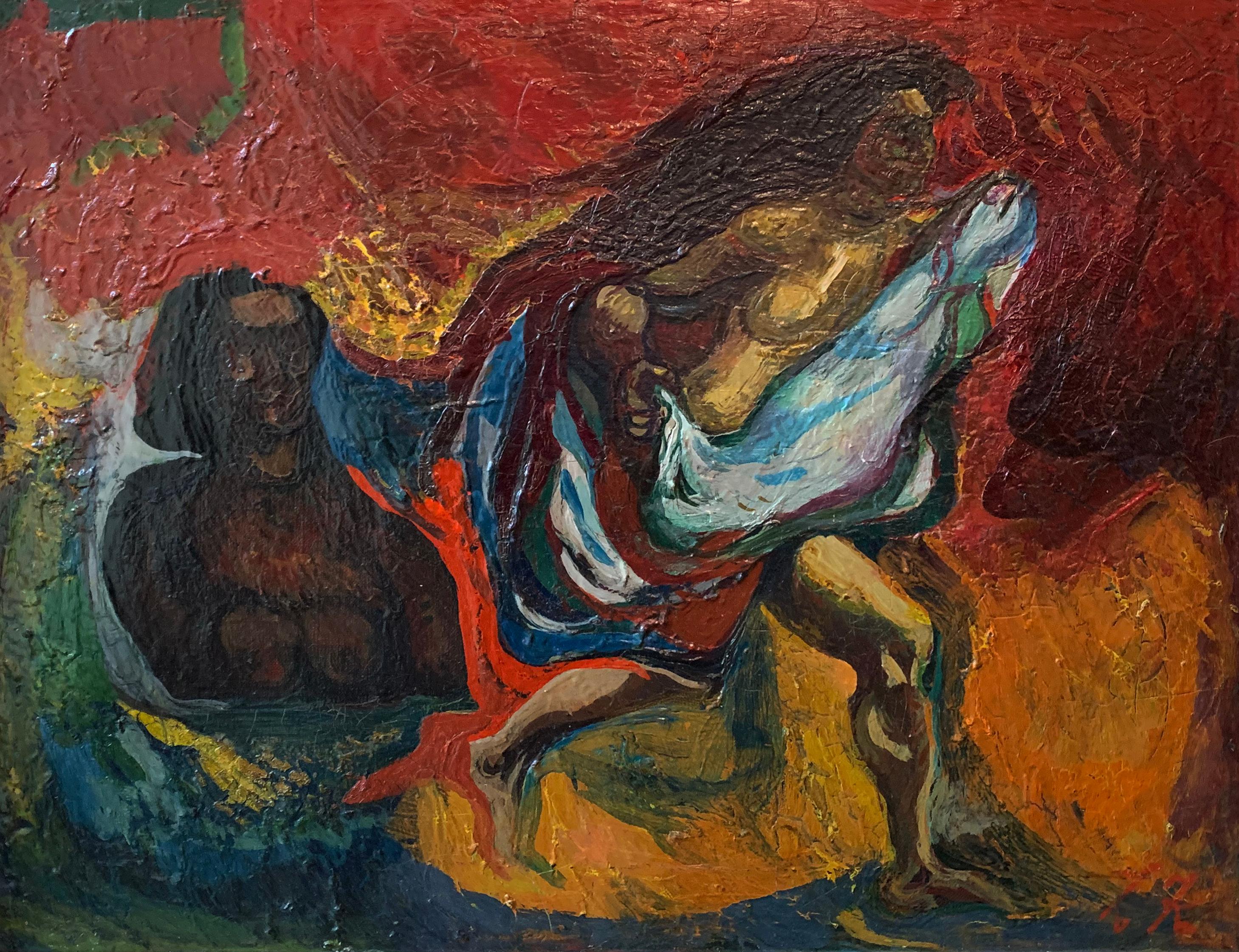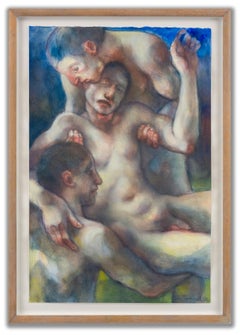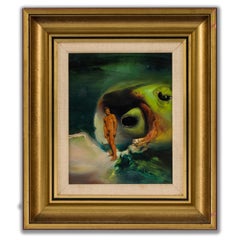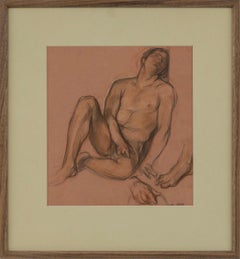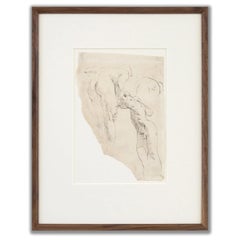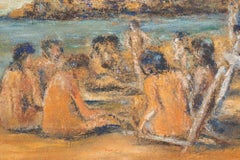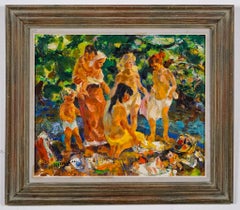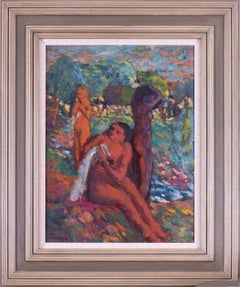Items Similar to Bathers (The Tempest)
Want more images or videos?
Request additional images or videos from the seller
1 of 11
Giovannia ColacicchiBathers (The Tempest)1933
1933
Price Upon Request
Price Upon Request
Price Upon Request
Price Upon Request
Price Upon Request
Price Upon Request
Price Upon Request
Price Upon Request
Price Upon Request
Price Upon Request
About the Item
Oil on canvas
Signed (lower right)
75cm × 75cm (93cm × 95cm framed)
An influential figurative painter of the 20th century. From 1928 to 1948, he exhibited his work regularly at the Venice Biennale. His work is held is many public collections in Italy. In 1940, he became a professor at Florence’s Accademia di Bella Arti, a position he would hold until 1970. In 1932 Colacicchi painted ‘Fine d’Estate (End of Summer)’, (now in the collection of Modern Art, Uffizi, Florence) to which this painting relates. This work, slightly different in composition to the work a year earlier, is painted far more freely that his usual style.
- Creator:Giovannia Colacicchi
- Creation Year:1933
- Dimensions:Height: 36.62 in (93 cm)Width: 37.41 in (95 cm)
- Medium:
- Movement & Style:
- Period:
- Condition:
- Gallery Location:London, GB
- Reference Number:Seller: Colacicchi, Tempest1stDibs: LU2263216518122
About the Seller
5.0
Vetted Professional Seller
Every seller passes strict standards for authenticity and reliability
Established in 2013
1stDibs seller since 2022
5 sales on 1stDibs
Typical response time: 2 hours
- ShippingRetrieving quote...Shipping from: London, United Kingdom
- Return Policy
More From This Seller
View AllThree Figures
Located in London, GB
Watercolour and pencil on paper, 76cm x 51cm, (87cm x 61cm framed).
Born in London to his renowned artist mother Elisabeth Frink RA and a French architect father, Michel Jammet, Ja...
Category
1990s Post-War Nude Drawings and Watercolors
Materials
Paper, Watercolor
Figure in a Psychoscape III
Located in London, GB
Oil on board
Signed (lower right)
24.5cm × 19cm (40cm × 35cm framed)
An artist, who also served on the board of the National Gallery of Australia, was a truly original painter. By t...
Category
1980s Post-War Nude Paintings
Materials
Oil, Board
Figure Study
By Charles Haslewood Shannon
Located in London, GB
Red and black chalk on paper, with white highlights
Initialed ‘CHS’ and dated (lower right)
27cm × 25cm (43cm × 39cm framed)
Shannon studied at Lincoln School of Art and at Lambeth ...
Category
19th Century English School Figurative Drawings and Watercolors
Materials
Paper, Chalk
Figure Studies
Located in London, GB
Pen and ink on paper
23cm × 16cm (42cm × 33cm framed)
Provenance:
From the collection of Michael Leonard
First exhibiting at the RA in 1904, Philpot was elected as an Academician i...
Category
Early 20th Century Figurative Drawings and Watercolors
Materials
Paper, Ink, Pen
Academic Study
Located in London, GB
Oil on canvas
Signed, dated and dedicated (upper right)
46cm × 38cm (59cm × 51cm framed)
Forichon was a pupil of the Ecole des Beaux-Arts de Paris and was taught by Jean-Léon Gérôme...
Category
1880s French School Figurative Paintings
Materials
Canvas, Oil
Untitled
Located in London, GB
Pen and ink on paper
Signed and dated (lower right)
28cm × 38cm (42cm × 50cm framed)
A Colombian painter, draughtsman and lithographer, known for his depictions of the male nude, wi...
Category
1970s Contemporary Figurative Prints
Materials
Paper, Ink, Pen
You May Also Like
Bathers on the Beach - Oil Paint by Pino Romanò - 1999
Located in Roma, IT
Oil on canvas realized by Pino Romanò (1934) in 1990s.
Hand signed. Titled on rear.
Very good condition.
Category
1990s Contemporary Figurative Paintings
Materials
Canvas, Oil
$379 Sale Price
20% Off
Bathers
By John Edward Costigan
Located in Sheffield, MA
John Edward Costigan, N.A.
American, 1888-1972
Bathers
Oil on canvas
Signed ‘J.E. Costigan N.A.’ lower left
20 by 24 in. W/frame 26 by 30 in.
John Costigan was born of Irish-American parents in Providence, Rhode Island, February 29, 1888. He was a cousin of the noted American showman, George M. Cohan, whose parents brought the young Costigan to New York City and was instrumental in starting him on a career in the visual arts. They were less successful in encouraging him to pursue formal studies at the Art Students League (where, however, he later taught) than in exposing him to the commercial art world through the job they had gotten him with the New York lithographing firm that made their theatrical posters.
At the H. C. Miner Lithographing Company, Costigan worked his way up from his entry job as a pressroom helper, through various apprenticeships, to the position of sketch artist. In the latter capacity he was an uncredited designer of posters for the Ziegfeld Follies and for numerous silent films. Meanwhile, he had supplemented his very meager formal studies in the fine arts with a self-teaching discipline that led to his first professional recognition in 1920 with the receipt of prizes for an oil painting and watercolor in separate New York exhibitions.
A year earlier, Costigan had wed professional model Ida Blessin, with whom he established residence and began raising a family in the sleepy little rural New York hamlet of Orangeburg, the setting for the many idyllic farm landscapes and wood interiors with which he was to become identified in a career that would span half a century.
John Costigan’s first national recognition came in 1922 with his winning of the coveted Peterson Purchase prize of the Art Institute of Chicago for an oil on canvas, “Sheep at the Brook.” It marked the start of an unbroken winning streak that would gain him at least one important prize per year for the remainder of the decade. The nation’s art journalists and critics began to take notice, making him the recurring subject of newspaper features and magazine articles. The eminent author and critic Edgar Holger Cahill was just a fledgling reporter when he wrote his first feature, “John Costigan Carries the Flame,” for Shadowland Magazine in 1922. Costigan had his first one-man show of paintings at the Rehn Gallery on New York’s 5th Avenue in November, 1924, to be followed less than three years later by another at the Art Institute of Chicago. In addition, Costigan’s work has been—and continues to be included, side-by-side with that of some of America’s most high-profile artists, in museum and gallery exhibitions throughout the country. His renown had peaked in the early 1930s, by which time his work had been honored with nearly every major award then being bestowed in the fine arts and had been acquired for the permanent collections of several prestigious American museums, including New York’s Metropolitan (which only recently, in 1997, deaccessioned his “Wood Interior,” acquired in 1934).
Although Costigan’s celebrity had ebbed by the late 1930s, the Smithsonian Institution saw fit in 1937 to host an exhibition exclusively of his etchings. And, in 1941, the Corcoran Gallery (also Washington, D.C.) similarly honored him for his watercolors. (Another Washington institution, the Library of Congress, today includes 22 Costigan etchings and lithographs in its permanent print collection.)
During World War II, Costigan returned briefly to illustrating, mainly for Bluebook, a men’s pulp adventure magazine. A gradual revival of interest in his more serious work began at the end of the war, culminating in 1968 with the mounting of a 50-year Costigan retrospective at the Paine Art Center and Arboretum in Oshkosh, Wisconsin. Oils, watercolors and prints were borrowed from museums and private collections throughout the country, and the exhibition was subsequently toured nationally by the Smithsonian Institution.
John Costigan died of pneumonia in Nyack, NY, August 5, 1972, just months after receiving his final prestigious award —the Benjamin West Clinedinst Medal of the Artist’s Fellowship, Inc., presented in general recognition of his “...achievement of exceptional artistic merit...” in the various media he had mastered in the course of his career.
This painting depicts one of the artist's favorite themes --the farm family bathing...
Category
1950s Post-Impressionist Figurative Paintings
Materials
Oil
Fernande Horovitz-Edwards, Bathers, Large Oil on Canvas, 1930s
Located in Saint Amans des cots, FR
Large Oil on Canvas by Fernande Horovitz-Edwards, France, 1930s - "Bathers". This large oil on canvas by Fernande Horovitz-Edwards, titled Bathers, dates from the 1930s and showcases...
Category
1930s Post-Impressionist Figurative Paintings
Materials
Canvas, Oil
American oil painting 'Bathers II' by Frederick Little Packer
Located in Petworth, West Sussex
Frederick Little Packer (American, 1886–1956)
Bathers II
Oil on board
Signed and inscribed with title (on a label, on the reverse)
19 ¾ x 15 in. (50.2 x 38.3 cm)
Radiant and rhythmic...
Category
20th Century Post-Impressionist Figurative Paintings
Materials
Oil, Board
Bathers, Modernist Nudes, Oil on Canvas, Signed and Titled
By Leon Kelly
Located in Doylestown, PA
"Bathers" by Philadelphia born modernist painter Leon Kelly, is a fantasy nude scene of two female figures, one with towel in hand, one only depicted as a portrait within the paintin...
Category
20th Century American Modern Nude Paintings
Materials
Canvas, Oil
$4,125 Sale Price
44% Off
Bathing Group
By John Edward Costigan
Located in Sheffield, MA
John Edward Costigan
American, 1888-1972
Bathing Group
Oil on canvas board
12 by 16 in, w/ frame 19 by 23 in
Signed ‘J.E. Costigan N.A.’ lower left
John Costigan was born of Irish-...
Category
Mid-20th Century Modern Paintings
Materials
Oil
More Ways To Browse
Iyiola Odunayo
Jean Beraud
Jean Jacques Henner Oil Painting
Joyce Roybal
Lady Godiva
Lingerie Painting
Luca Giordano
Mother With Children Painting
Nugzar Kakhiani
Oil Paintings Of Sailor
Oil Paintings Of Swimmers
Oil Paintings With Cherubs
Old Russian Painting
Omar Abdel Zaher
Painting Of Milan
Paintings Cossacks
Paul Elie Gernez
Pensive Girl
